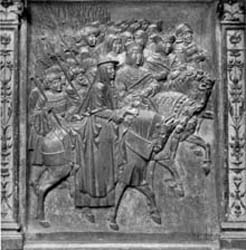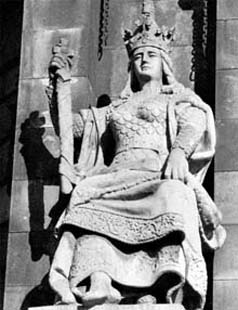Warrior Queens: Boadicea's Chariot (74 page)
Read Warrior Queens: Boadicea's Chariot Online
Authors: Antonia Fraser
Tags: #History, #General, #Social History, #World

The tomb of Countess Matilda in St Peter’s, Rome, with a Latin inscription comparing her to the Amaon leader: ‘this warrior-woman disposed her troops as … Penthesilea is accustomed to do’.

A nineteenth-century Belgian evocation of the scene at Canossa, painted by Alfred Cluysenaar.

Fifteenth-century depiction of the Empress Maud (Matilda), claimant to the throne of England, from a history of England written by monks at St Albans.

The monogram of Queen Tamara, formed from the letters
TAMAR
in the Georgian knightly hand, and employed in the copper coinage of her reign.

Queen Tamara of Georgia; an engraving published in 1859.

Marble bust of Shota Rustaveli, the national poet of Georgia, author of
The Knight in Panther’s Skin
, and Queen Tamara’s court official, possibly her Royal Treasurer; sculpted in 1938 by Yakov Nikoladze.

Triumphal entry of Ferdinand and Isabella, ‘the Catholic kings’ of Spain, into Granada in January 1492 following the conquest of the last Moorish kingdom; a bas-relief on the altar of the Royal Chapel in the Cathedral.

Isabella of Spain, a detail from the Columbus Monument in Barcelona, commemorating the fact that the Queen, as well as her husband, authorized Columbus’ voyage to the new world in 1492.

Medal (
c
. 1480) showing Caterina Sforza, the spirited daughter of the Duke of Milan; her fate, as a would-be female ruler of Forlì, contrasted unhappily with that of Isabella of Spain.

Queen Isabella of Spain; a detail from the painting
The Madonna of the Catholic Kings
.

The earliest loose popular print of Queen Elizabeth I: William Rogers’
Eliza, Triumphans
of 1589 (the year following the defeat of the Spanish Armada) shows the Queen as Peace, with an olive branch in her hand, while Victory and Plenty proffer her their crowns.

Queen Elizabeth and the Three Goddesses
(Juno, Pallas Athene and Venus seen against a background of Windsor Castle), attributed to Joris Hoefnagel, 1569; it has been suggested that this allegorical picture refers to the Queen’s suppression of the Northern Rebellion, the first military initiative of her reign.
